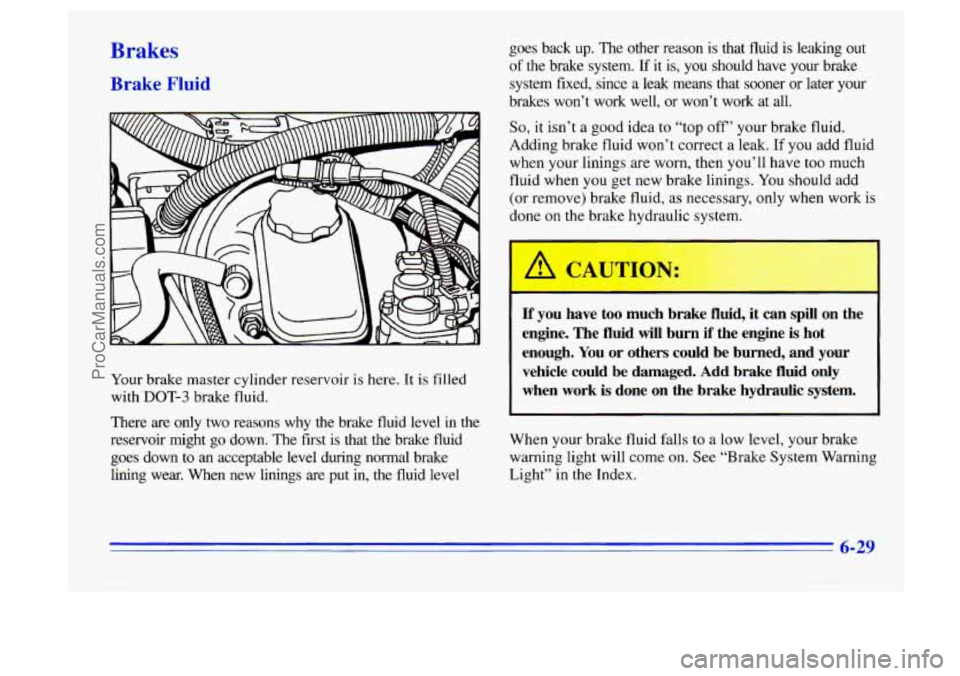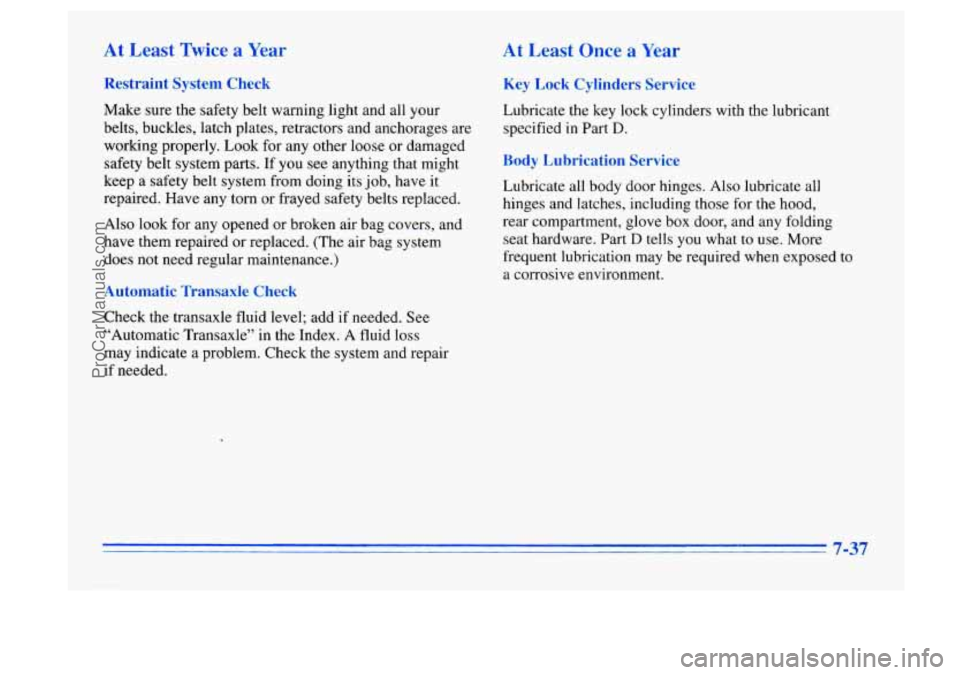1996 BUICK CENTURY warning light
[x] Cancel search: warning lightPage 149 of 340

City Driving
One of the biggest problems with city streets is the
amount of traffic on them. You’ll want to watch out for
what the other drivers are doing and pay attention to
traffic signals. Here
are ways to increase your safety
in city driving:
0 Know the best way to get to where you are going. Get
a city map and plan your trip into an unknown part of
the city just
as you would for a cross-country trip.
0 Try to use the freeways that rim and crisscross mo
large cities. You’ll save time and energy. (See the
next part, “Freeway Driving.”) st
0 Treat a green light as a warning signal. A traffic
light is there because the corner
is busy enough to
need it. When a light turns green, and just before
you start to move, check both ways for vehicles tha t
have not cleared the intersection or may be running
the red light.
ProCarManuals.com
Page 154 of 340

W* kter Driving
Here are some tips for winter driving:
Have your Buick in good shape for winter.
You may want to put winter emergency supplies in
your vehicle. Include
an ice scraper, a small brush or broom, a supply
of windshield washer fluid, a rag, some winter outer
clothing, a
small shovel, a flashlight, a red cloth and a
couple of reflective warning triangles. And, if you will
be driving under severe conditions, include a small bag
of sand, a piece of old carpet or a couple of burlap bags
to help provide traction. Be sure you properly secure
these item
in your vehicle.
4-24
ProCarManuals.com
Page 179 of 340

Engine Overheating
You will find a coolant temperature gage or the
warning light about a hot engine on
your Buick’s
instrument panel.
If St1 .-m Is 1 - - ng Fro Your Engine
Steam from an overheated engine can burn you
badly, even if you just open the hood. Stay away
from the engine if you see or hear steam coming
from it. Just turn
it off and get everyone away
from the vehicle until
it cools down. Wait until
there is no sign of steam or coolant before
opening the hood.
If you keep driving when your engine is
overheated, the liquids in it can catch fire. You or
others could be badly burned. Stop your engine if
it overheats, and get out of the vehicle until the
engine is cool.
NOTICE:
If your engine catches fire because you keep
driving with no coolant, your vehicle can be
badly damaged. The costly repairs would not be
covered by your warranty.
5-13
ProCarManuals.com
Page 235 of 340

Brakes
Bra
Your brake master cylinder reservoir is here. It is filled
with
DOT-3 brake fluid.
There are
only two reasons why the brake fluid level in the
reservoir might go down. The first is that the brake fluid
goes down to an acceptable level during normal brake
lining wear. When new linings are put in, the fluid level goes
back up. The other reason is that fluid is leaking out
of the brake system. If it is, you should have your brake
system fixed, since a leak means that sooner or later your
brakes won’t work well, or won’t work at all.
So, it isn’t a good idea to “top off’ your brake fluid.
Adding brake fluid won’t correct a leak.
If you add fluid
when your linings are worn, then you’ll have too much
fluid when you get new brake linings.
You should add
(or remove) brake fluid,
as necessary, only when work is
done on the brake hydraulic system.
If you have too much brake fluid, it can spill on the
engine. The fluid
will burn if the engine is hot
enough. You or others could be burned, and your
vehicle could be damaged. Add brake fluid
only
when work is done on the brake hydraulic system.
When your brake fluid falls to a low level, your brake
warning light will come on.
See “Brake System Warning
Light”
in the Index.
ProCarManuals.com
Page 237 of 340

Brake Wear
Your Buick has front disc brakes and rear drum brakes.
Disc brake pads have built-in wear indicators that make a
high-pitched warning sound when the brake pads are worn
and new pads are needed.
The sound may come and go or
be heard all
the time your vehicle is moving (except when
you are pushing on the brake pedal firmly).
A CAUTION:
The brake wear warning sound means that
sooner or later your brakes won’t work well.
That could lead to an accident. When you hear
the brake wear warning sound, have your
vehicle serviced.
NOTICE:
Continuing to drive with worn-out brake pads
could result in costly brake repair.
Some driving conditions or climates may cause a brake
squeal when the brakes are first applied or lightly applied.
This does not mean something
is wrong with your brakes.
Fre’- -1ovement
of brake calipers and properly torqued
wheel nuts are necessary to help prevent brake
pulsation. When tires are rotated, inspect brake calipers
for movement, brake pads for wear, and evenly torque
wheel nuts
in the proper sequence to GM specifications.
Your rear drum brakes don’t have wear indicators, but
if
you ever hear a rear brake rubbing noise, have the rear
brake linings inspected.
Also, the rear brake drums should
be removed and inspected each time the tires are removed
for rotation or changing. When you have the front brakes
replaced, have
the rear brakes inspected, too.
Brake linings should always be replaced as complete
axle sets.
Brake Pedal Travel
See your dealer if the brake pedal does not return to
normal height, or if there is
a rapid increase in pedal
travel. This could be
a sign of brake trouble.
Brake Adjustment
Every time you apply the brakes, with or without the
vehicle moving, your brakes adjust for wear.
6-31
ProCarManuals.com
Page 307 of 340

At Least Twice a Year
Restraint System Check
Make sure the safety belt warning light and all your
belts, buckles, latch plates, retractors and anchorages are
working properly. Look for any other loose or damaged
safety belt system parts. If you see anything that might
keep a safety belt system from doing its job, have it
repaired. Have any torn or frayed safety belts replaced.
Also look for
any opened or broken air bag covers, and
have them repaired or replaced. (The air bag system
does not need regular maintenance.)
Automatic Transaxle Check
Check the transaxle fluid level; add if needed. See
“Automatic Transaxle” in the Index. A fluid loss
may indicate a problem. Check the system and repair
if needed.
At Least Once a Year
Key Lock Cylinders Service
Lubricate the key lock cylinders with the lubricant
specified
in Part D.
Body Lubrication Service
Lubricate all body door hinges. Also lubricate all
hinges and latches, including those for the hood,
rear compartment, glove box door, and any folding
seat hardware. Part
D tells you what to use. More
frequent lubrication may be required when exposed to
a corrosive environment.
7-37
ProCarManuals.com
Page 329 of 340

Section 9 Index
Air Bag ...................................... I -2 1
How Does it Restrain .......................... 1-23
How it Works ................................ 1-22
Location
.................................... 1-22
Readiness Light
......................... 1-21? 2-49
Servicing
................................... 1-25
What Makes
it Inflate .......................... 2-23
What Will
You See After it Inflates ............... 1-24
When Should it Inflate
......................... 1-23
Aircleaner
.................................... 6-14
Air Conditioning
................................ 3-2
Air Conditioning Refrigerants
..................... 6-64
Alignment and Balance. Tire
...................... 6-43
Aluminum Wheels. Cleaning
...................... 6-5 I
Antenna. Fixed ................................. 3-10
Antifreeze
..................................... 6-22
Anti-Lock Brake System Active Light
................. 2-53. 4.8
Brake System Warning Light
................ 2-5 1. 4.6
Brakes
...................................... 4-6
Appearancecare
............................... 6-46
Appearance Care Materials
....................... 6-54
Arbitration Program
.............................. 8-6
Armrest. Storage
............................... 2-39
Ashtrays
...................................... 2-42 Audio
Equipment. Adding
......................... 3-9
Audio Systems
.................................. 3-4
Automatic Door Locks
............................ 2-4
Automatic Overdrive
............................ 2-17
Automatic Transaxle Check
....................... 7-38
Automatic Transaxle Fluid
........................ 6-17
Automatic Transaxle Operation
.................... 2-16
Shifting
..................................... 2-16
Automatic Transaxle Park Mechanism Check
......... 7-40
Battery
...................................... 6.3 2
Jump Starting
................................. 5-2
Warning Light
............................... 2-50
Warnings
................................ 5.2. 5.4
BBB Auto Line ................................. 8-6
Better Business Bureau Mediation
................... 8-6
Brake Replacement.
Remote Keyless Entry
............... 2-6
Adjustment
.................................. 6-31
Fluid
....................................... 6-29
Master Cylinder
.............................. 6-29
Parking
..................................... 2-19
PedalTravel
................................. 6-31
Replacing System Parts
........................ 6-32
System Warning Light
......................... 2-50
9-1
ProCarManuals.com
Page 331 of 340

Cruise Control .................................. 2-30
Cupholders
.................................... 2-39
Customer Assistance Information
................... 8- 1
Customer Satisfaction Procedure .................... 8- 1
Damage. Finish ............................... 6-52
Damage. Sheet Metal
............................ 6-52
Daytime Running Lamps
......................... 2-34
Dead Battery
................................... 5-2
Defects. Reporting Safety
......................... 8-7
Defensive Driving
............................... 4- 1
Defogger. Rear Window
.......................... 3-3
Defogging
..................................... 3-2
Defrosting
..................................... 3-2
Dimensions. Vehicle
............................ 6-63
Door
Drive Position. Automatic Transaxle
................ 2- 18
Driver Position
................................. 1 - 13
Driving
City
....................................... 4-19
Defensive
.................................... 4-1
Drunken
..................................... 4-2
Freeway
.................................... 4-20
In a Blizzard ................................. 4-26
In Foreign Countries
........................... 6-4
IntheRain
.................................. 4-16
Night
...................................... 4-14
OnCurves
................................... 4-9
On Grades While Towing a Trailer ............... 4-35
On Hill and Mountain Roads
.................... 4-22
Customer Assistance for
Text Telephone Users
......... 8-3
Locks
....................................... 2-3 OnSnowandIce
............................. 4-25
Wet Roads
.................................. 4-16
Winter ...................................... 4-24
With a Trailer
................................ 4-34
DrunkenDriving
................................ 4-2
Electrical Equipment. Adding
................ 3-9. 6-56
Electrical System
............................... 6-56
Engine 6-8. 6-9
Engine
Coolant
..................................... 6-22
Coolant Heater
............................... 2-14
Coolant Level Check
.......................... 7-37
Coolant Temperature Gage
..................... 2-54
Exhaust
..................................... 2-24
Identification
................................ 6-55
OilLevelCheck
.............................. 7-37
Overheating
................................. 5-13
Running While Parked ......................... 2-24
Specifications
................................ 6-63
Starting Your
........................... 2- 12. 2-13
Engineoil
.................................... 6-10
Adding
..................................... 6-12
Additives
................................... 6-13
Checking
................................... 6-10
Used
....................................... 6-14
Whentochange
.............................. 6-14
Engine
Oil Pressure Light ........................ 2-57
Ethanol
........................................ 6-3
Through Deep Standing
Water
................... 4-18
Coolant Temperature Warning Light
.............. 2-53
Exhaust. Engine
................................ 2-24
9-3
ProCarManuals.com